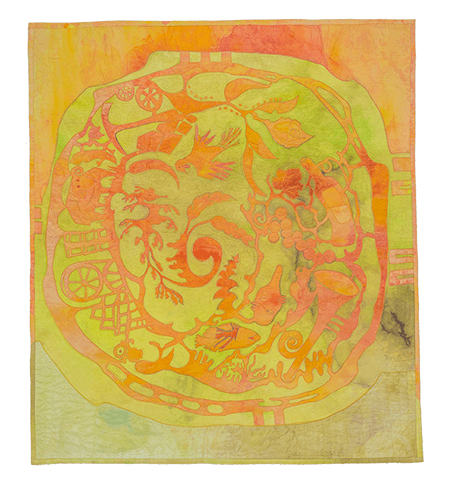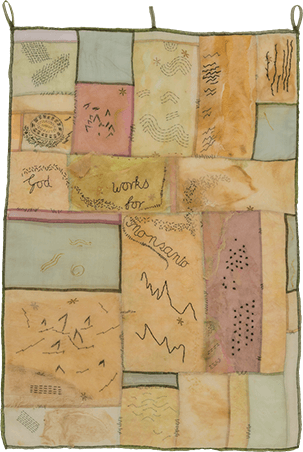MARJORIE COLEMAN: 'IN HER OWN WORDS'
MARJORIE COLEMAN:
'IN HER OWN WORDS'
The following extracts are drawn from the publication MARJORIE COLEMAN – Lyrical Stitch, launched at Holmes à Court Gallery in 2020
The Story
When I look back, my endeavours have been a series of explorations of techniques, cultural customs of places I have lived in, types of fabric, expressions of my own background and experience, and I suppose, my thinking.
Even when I made what I thought of as “Quilts” I needed to add my own twist for good or ill… for wall or bed which often people did not quite ‘get’. If this display looks eclectic it is because it is… Wandering around the stitched textile world my sensibility has developed such that pieces which I discarded 20 or 30 years ago I now see as worthy of finishing off.
I was of the era when children were seen and not heard; when table (and general) manners were perhaps the ultimate morality and you did as you were told, no questions. If that sounds sad, it had its upside: you lived with your fantasy playmates (mine was Macorbin!) and you invented games and situations for yourself, inside yourself. You imagined.
READ MORE...
The spectacular flower to the fore is a large “prionotes” banksia with two attendant birds which are free-standing. They are the accurately represented Western Spinebill and a larger bird which is an amalgam of the New Holland honeyeater and the Large Wattle Bird all of which are Honey Eaters and pollinators of Banksias. The English piecing down the sides of the quilt also represents banksias.
Play is made of the word ‘everlasting’ so the elements represent the past, the present and the ongoing, as well as the paper-like flower. The colours are those of everlastings; yellows, whites and pinks. The ‘light spots’ are hexagons, used so much in traditional patchwork, and traditional patterns are scattered over the surface in the quilting to represent the past.
The bird is an attendant honeyeater but also suggests the ‘everlasting’ – if one wished to see the Holy Spirit or the dove of peace that is fine.
I drew first and I always draw from life (we had lots of spider orchids on our farm block). I spent hours getting the orchid ‘right’. I tried many shapes more realistic but had to get simpler and drop detail after detail. I wanted to suggest a simplicity which conceals a great deal of complication, delicacy which conceals toughness.
All the quilts I have made were explorations and though I have never copied a quilt, my early ones were of my own designs expressed in traditional techniques. They were quite successful and since I was using Australian native plants as my theme, before it became popular, they attracted attention
I think it important to use one’s own thoughts, the perceptions and loves of one’s own time and place, rather than someone else’s hand-me-downs; the past used for the steps it can suggest, rather than for the provision of present substance.
But they were not where I wished to be, though I knew that each one made me a step nearer to the radical and even outrageous which I want. But it’s a hard slog with my temperament. I was brought up 'proper' by an English Mother and that’s a hard mask to shed and at times I fear that I am a generation too late.
… CLOSE

Australian Bounty: #1 Sunburst, 1999 125 x 109 cm, hand dyed taffeta, hand stitching – To remark on the energy and munificence and rarities which are revealed in Australia.
We wanted to snorkel in the Pacific. Several times we crossed to the Eastern seaboard, which was expensive; so, we decided to rent our house in Cottesloe and move to the East for say, a year. We settled in Caloundra on the Sunshine Coast (Queensland) and stayed for seven years. We snorkeled on Lord Howe, Vanuatu, Fiji, Lady Eliot, New Caledonia. It was a great time.
It was also fruitful for my textile development and explorations. It seemed that Queensland was much more eclectic in its Art ethos. The Queensland Gallery for instance would show textile in with any oil or print or drawing, which might be relevant to a theme. This seemed very different to that which I was used to in Perth; though not in USA, where textiles was not regarded as a hobby and/or female preoccupation.
I joined a group of people interested in weaving, tapestry, stitching, quilting, ceramics, dyeing, and anything else of a craft-art flavour, and it opened possibilities to me. We had workshops and discussions and a couple of exhibitions in Brisbane and often ventured forth to regional exhibitions of interest such as Noosa, Maroochydore, Maleny, and Brisbane.
The University of the Third Age was very active in Caloundra and I spent weekly sessions absorbing this and that, with great profit and stimulation.
We moved back to Perth for family reasons which I have to confess left me a little lost for a time.
I have always felt that nostalgia, whether it be in architecture or needlework or whatever, is good emotion wasted. I suppose, temperamentally, I was already looking to speak with my own scissors and threads rather than someone else’s. I was given to understand that what was around me, my experiences, in my voice, was not quite the thing.
I suppose it was a certain stubborn self-preservation which stopped me in mid-stitch as I was applying a breadfruit in the Hawaiian manner (from a bought pattern) – I am an Australian, not a Hawaiian, so why am I stitching breadfruit?
When I returned to Australia, I started stitching quilts of my own imaginings. They evolved because I don’t like to copy, and I wanted to show things based on my own experience. In the early eighties, before it was popular, I was interested in using indigenous plant forms in quilts, which celebrated the shapes and colours of the plants.
Among others, I developed five quilts which I call the ‘Dullflower’ series. They depict native plants and the title is a wry salute to those who find boredom in the Australian bush and are aimed at exploring wildflower shapes using a different approach in each.
READ MORE...
My Mother was a WW1 war bride; upper middle class whose parents owned a pub in Birmingham UK, so she and her sister went to boarding school at an early age to get away from it… so no Family Life to teach her things. And I was an only child on a farm, Weedon Hill overlooking Wilsons Inlet, Denmark, WA… so no Family Life to teach me things either.
My Father was a staff Surveyor (Lands Dept) and away from home for months at a time. Sometimes my Mother and I would go and stay with him in the survey camp if he was going to be in one spot for some time and because when school age, I had Correspondence lessons the lessons could go too… so no school friends to teach me things.
When I was eight, we moved to Albany where I had been born and as my Father was by now District Surveyor, we became a family and I went to the State school. I loved it; being with other kids, even the ones who could be nasty.
When I was ten, we moved to Perth and after a couple of years at Claremont Central I went to PLC… only two dozen girls in the class instead of fifty-four… I began to learn how to mix.
I did well and will always be grateful to my Father who took it for granted that I would go to the University. He had left school at twelve… but by reading widely became very well self-educated.
UWA was a new wonderful world. There were less than two thousand students and we had lunch on Whitfield Court with engineers, lawyers, scientists and us arts lot… we discussed everything.
I married one of the lot, a geologist on the staff who had been appointed to Sydney University; so we got married in Sydney. After some years we moved back to Perth with a growing and enlarging family. I stitched baby clothes, then children clothes, and I had always made my own dresses, which I liked to be a little different.
Going on Study Leave for a year was the way then, so we upped and off with a new baby and small kids, for a year in Baton Rouge, Louisiana, at the University of Louisiana, 1962–63. Kennedy was shot and some of the school kids cheered we were told.
Then 1972 University of Hawaii; 1980 Columbia University, New York; and in the eighties and nineties six month stints at the University of Hawaii again. I had five children who went to school in Hawaii. Since I was not eligible for a green card, I stayed home and sewed and had a good social life with like wives of Faculty members.
I have always sewn, doll’s dresses, my dresses, my children’s dresses – a different world – and I embroidered this and that.
Liberty House had a sale on, so I bought a kit for $US12 and followed the rather sparse instructions. It was a classic Tree of Life. Not what I had been seeing around me, but it showed me that I could.
I discovered Hawaiian quilts, a specialty of Hawaiian women, and bought a few patterns but soon realized that since I was not Hawaiian, I had better make my own using Australian plants, which when I came home, I taught and sold. In the seventies I went to Claremont Technical School, which was an Art school, and did painting, drawing, and textile classes for three years part time. This gave substance to what had been pretty light-weight and sporadic.
I have never wanted to just reproduce a traditional pattern but always added my own twist also in the fabric which would suit my thinking rather than quilterly cloth. The recurrent themes that appear throughout my work mostly revolve around Australian botany, marine life, and bird life. In the beginning my ideas were fairly simplistic representations of native plants; then I incorporated philosophical and political ideas into the themes I was stitching. I have also stitched social commentary and representations of my own special memories.
The needle is my stylus, the thread my pigment. I like to express ideas… I can’t help it.
… CLOSE
I am Australian of this day and age, and I want the images, effects, and colours that I use to arise out of my own experience rather than to speak of another time and place. It is literature, philosophy and psychology that informs much of my work. Politics has always interested me; and I have stitched several political pieces.
I have also stitched social commentary.
I would like to make pieces which speak to people who are not interested in quilts, to use a quilter’s insights and skills to lure in those who dismiss quilts as largely busywork. I do not know if I am making quilts or textile pieces. I don’t think I have joined the stick wrappers and keep vigilant control over my lunatic tendencies; perhaps they do not sit well in general shows and of course no one wants to own them. A quilt can stand for many things.
For the marriage bed, for cosy security, for thrifty make-do (Waggas), for ceremonial gifts… and as a political statement. Stitches and words serve the same purpose and become one. Things stitched:
Some are for fun...
Some are for exhibiting...
Some are for teaching...
Some are to find something out.

Landscape (God works for Monsanto), 1990's
68 x 49 cm, hand dyed silk, cotton, hand and machine stitching – Irritation at Monsanto’s philosophy.
POETIC RESPONSES
MARJORIE COLEMAN 2025